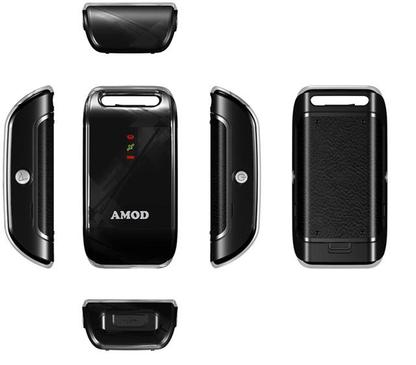Good experience with the Amod AGL 3080 GPS logger
I liked my trusty Sony GPS-CS1 GPS logger, but autonomy of barely more than a good riding day was too short for my taste and the one Hertz sampling rate was too low for satisfactory OpenStreetMap surveying by bicycle or roller-skate, though it was plenty for walking.
After sifting through various reviews and specification sheets, I declared the Amod AGL 3080 the true heir to the Sony GPS-CS1. And after a few months of use I am not disappointed.
This solid little unit is simple to use : normal operation requires a single button. After mounting as USB mass storage with a standard mini-USB cable, a pass trough GPSbabel is all that is needed before the data is ready for consumption. There is also a handy second button for marking waypoints – I use it mostly to record points of interests. The AGL 3080’s SiRF Star III chipset provides satisfactory reception – subjectively much better than the GPS-CS1’s, and the storage capacity is more than you will need for anything up to a transcontinental ride. It uses three AAA batteries, which makes it practical for underway replenishment while making the use of rechargeables possible too. For a walkaround, PocketGPSWorld has a review with detailed pictures.
But what I appreciate most is the ability to configure the output NMEA sentences for the best compromise between autonomy and the richness of the of logged data. 6 logging modes can be by cycled through by pressing the “MARK” button for as much precision or as much battery life as you wish to adjust as you go :
| Mode | LED Status | Output format | Interval (seconds) | Records | Duration (hours) |
| 1 | “Memory Full” on |
GGA/GSA/RMC/VTG | 1 | 260 000 | 72 |
| GSV | 5 | ||||
| 2 | “Memory Full” flash | Only RMC |
1 | 1 040 000 | 288 |
| 3 | “GPS” on | GGA/GSA/RMC/VTG/GSV | 5 | 260 000 | 360 |
| 4 | “Battery Low” on | Only RMC |
5 | 1 040 000 | 1440 |
| 5 | “Battery Low” on | GGA/GSA/RMC/VTG/GSV | 10 | 260 000 | 720 |
| 6 | “Battery Low” flash | Only RMC | 10 | 1 040 000 | 2880 |
The not so good is that the absence of rubber gasket on the battery compartment hints that this device is not waterproof. Like the Sony GPS-CS1 it has been through rain with no apparent problem, but pushing my luck too far will probably result in corrosion.
The ugly is that I have yet to find a way to strap the Amod AGL 3080 securely. It features a strap slot on only one side, making any balanced setup impossible. Supplied Velcro strap can connect it to a carabiner, but the resulting contraption dangles around wherever you attach it – I hate to have dangling things attached to my kit. The Sony GPS-CS1has a pouch that features a convenient Velcro strap to conveniently attach it to a any strap – I use it on top of my backpack’s shoulder straps or on top of my handlebar bag. The Amod AGL 3080 has nothing like that and I have yet to find a good way to mount it on my bicycle – for now, rubber-bands are the least worst option.
But for 70 Euros, it is a bargain if you need a cheap, simple and flexible GPS logger for photography, sports or cartography. Buy it – and then tell me if how you succeeded in mounting it on a bicycle or on a backpack !
2 responses to “Good experience with the Amod AGL 3080 GPS logger”
Leave a Reply
You must be logged in to post a comment.

Hi,
Trying to get to grips with the AMOD AGL 3080 – seems good so far. Latitude and longitude reliability appear to be much better than altitude…but I think that’s the same with all GPS devices really.
Just wondering how accurate it is…Do you happen to know if it uses EGNOS (European Geostationary Navigation Overlay System) to provide extra accuracy?
Thanks,
Anna
I’m afraid I don’t know if it does use EGNOS… But If you find that information, please feel free to post it here.